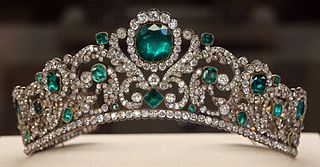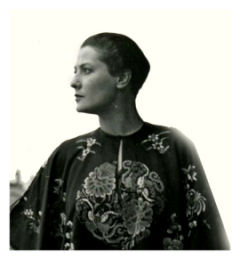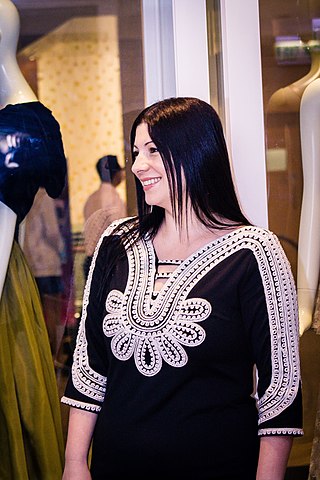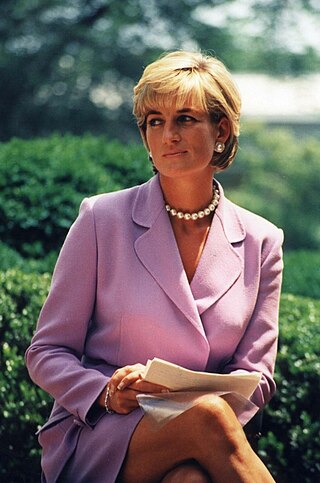Related Research Articles

Jewellery consists of decorative items worn for personal adornment, such as brooches, rings, necklaces, earrings, pendants, bracelets, and cufflinks. Jewellery may be attached to the body or the clothes. From a western perspective, the term is restricted to durable ornaments, excluding flowers for example. For many centuries metal such as gold often combined with gemstones, has been the normal material for jewellery, but other materials such as glass, shells and other plant materials may be used.

A tiara is a jeweled head ornament. Its origins date back to ancient Iran, which was then adapted by Greco-Romans. In the late 18th century, the tiara came into fashion in Europe as a prestigious piece of jewelry to be worn by women at formal occasions. The basic shape of the modern tiara is a semi-circle, usually made of silver, gold or platinum and richly decorated with precious stones, pearls or cameos.

A pendant is a loose-hanging piece of jewellery, generally attached by a small loop to a necklace, which may be known as a "pendant necklace". A pendant earring is an earring with a piece hanging down. Its name stems from the Latin word pendere and Old French word pendr, both of which translate to "to hang down". In modern French, pendant is the gerund form of pendre and also means "during". The extent to which the design of a pendant can be incorporated into an overall necklace makes it not always accurate to treat them as separate items.

Garrard & Co. Limited, formerly Asprey & Garrard Limited, designs and manufactures luxury jewellery and silver. George Wickes founded Garrard in London in 1735 and the brand is headquartered at Albemarle Street in Mayfair, London. Garrard also has a presence in a number of other locations globally. Garrard was the first official and most notably important Crown Jeweller of the United Kingdom having supplied jewels for Queen Victoria, and was charged with the upkeep of the British Crown Jewels, from 1843 to 2007, and was responsible for the creation of many tiaras and jewels still worn by the British royal family today. As well as jewellery, Garrard is known for having created some of the world's most illustrious sporting trophies, including the America's Cup, the ICC Cricket World Cup Trophy and a number of trophies for Royal Ascot in its role as Official Trophies and Silverware Supplier, which originally dates back to the first Gold Cup in 1842.

Queen Elizabeth II owned a historic collection of jewels – some as monarch and others as a private individual. They are separate from the gems and jewels of the Royal Collection, and from the coronation and state regalia that make up the Crown Jewels.
Cathy Waterman is a California based jewelry designer and a member of the Council of Fashion Designers of America. She designs “ethereal, feminine, lyrical” jewelry using recycled metals and fair trade stones.

Suzanne Belperron (1900–1983), born in Saint-Claude, France, was an influential 20th-century jewellery designer based in Paris. She worked for the Boivin and Herz jewellery houses before the outbreak of World War II. Subsequently, she took over the Herz company, renaming it Herz-Belperron. Belperron had many important clients, including royalty, arts and show business on both sides of the Atlantic.
Susan Foster is an American jewelry designer and philanthropist.
Hemmerle is a Munich-based jeweller founded in 1893 by brothers Joseph and Anton Hemmerle.

Pandora A/S is a Danish jewelry manufacturer and retailer founded in 1982 by Per Enevoldsen. The company started as a family-run jewelry shop in Copenhagen.

Shaun Leane is a British jewellery designer best known for his sculptural pieces created for Alexander McQueen. His eponymous jewellery brand is a four-time winner of the UK Jewellery Designer of the Year award.
Victorian jewellery originated in England. Victorian jewellery was produced during the reign of Queen Victoria, whose reign lasted from 1837 to 1901. Queen Victoria was an influential figure who established the different trends in Victorian jewellery. The amount of jewellery acquired throughout the Victorian era established a person’s identity and status. Within the Victorian period, jewellery consisted of a diverse variety of styles and fashions. These periods can be categorised into three distinct timeframes: The Romantic period, the Grand period and the Aesthetic period.

Narcisa Pheres is an entrepreneur and creative director and founder of PHERES and Narcisa Pheres Fine Jewelry, Italian luxury brand.
Azza Fahmy is an Egyptian jewellery designer, and the founder of the design house Azza Fahmy Jewellery. Fahmy was the first woman to train in Egypt's jewellery quarter, Khan El Khalili. In 2013 Fahmy founded ‘The Design Studio by Azza Fahmy’, in partnership with Alchimia, Contemporary Design School in Florence.

Diana, Princess of Wales, owned a collection of jewels both as a member of the British royal family and as a private individual. These were separate from the coronation and state regalia of the crown jewels. Most of her jewels were either presents from foreign royalty, on loan from Queen Elizabeth II, wedding presents, purchased by Diana herself, or heirlooms belonging to the Spencer family.

Fernando Pires Jorge is a Brazilian jewellery designer. He launched his eponymous fine jewellery brand in 2010, after completing an MA in design at Central Saint Martins (2008–2010).
Pippa Small MBE is a British jeweller, anthropologist and humanitarian. She is the owner of Pippa Small Jewellery.
Feng J or Feng Ji is a Paris-based Chinese jewelry designer and artist. She established her own eponymous jewelry brand in Paris and set up showrooms in Place Vendôme and Shanghai. In December 2015, she founded Fengji Jewelry (Shanghai) Co., Ltd. in Shanghai, serving as its executive director and general manager. The company has a registered capital of only RMB 1 million.
Khmer jewellery originated in the Khmer Empire. Khmer jewellery has been produced since the 6th or 7th century. Jayavarman VII, while he was an influential figure who established the different trends in Khmer jewellery, is famously represented without any at all in the seated position. The amount of jewellery acquired in Cambodia traditionally established a person's identity and status. Khmer jewellery consists of a diverse variety of styles and fashions. These styles can be categorised into three distinct groups: royal jewellery, wedding jewellery and the jewellery for the Cambodian Royal Ballet.
Anna Hu is a European-based Asian jewellery artist.
References
- 1 2 Davidson, Annabel (2020-02-14). "Meet Anabela Chan, the jeweller making fantastical floral earrings from recycled drinks cans". The Telegraph. ISSN 0307-1235 . Retrieved 2020-10-04.
- ↑ "ANABELA CHAN WOWS WITH RECYCLED ALUMINIUM JEWELLERY". Solitaire Magazine. 2020-03-24. Retrieved 2020-10-04.
- ↑ Laura McCreddie-Doak. "Can lab-grown diamonds replace the real thing?". CNN. Retrieved 2020-10-04.
- ↑ "Jeweler to the Stars Anabela Chan Turns Recycled Cans Into Fabulous Baubles — Why Beyonce and Taylor Swift Can't Get Enough". PaperCity Magazine. 2020-03-03. Retrieved 2020-10-04.
- ↑ Hailes, Stacey (2019-06-18). "London-based designer's lab-grown diamond jewels win starring role in Taylor Swift's new video". Professional Jeweller. Retrieved 2020-10-04.
- ↑ Liu, Ming (2020-08-30). "Finish Your Soda So She Can Make Some Earrings". The New York Times. ISSN 0362-4331 . Retrieved 2020-10-04.
- ↑ "Anabela Chan". Diamond Foundry. Retrieved 2020-10-04.